NCERT Class 9 Science Chapter 7 Notes Diversity In Living Organisms- Download PDF Notes
Diversity in living organisms from the NCERT book of the CBSE Board deals with the classification of organisms based on level of organisation. The NCERT Class 9 Science Chapter 7 notes provide a basic idea of the diversity in living organisms. The main topics covered in NCERT Class 9 Science notes are definitions, what is the basis of classification, classification and evolution, the hierarchy of classification-groups, five kingdoms: Monera, Protista, Fungi, Plantae and Animalia, Kingdom Plantae and animalia in detail, and nomenclature. Download the CBSE Notes for Class 9 Science, Chapter 7, PDF to use offline anywhere. Students must go through each concept, including diagrams and examples of diversity in living organisms in Class 9 Notes Science, in the easiest and most effective way possible with the help of NCERT Notes for Class 9.
This Story also Contains
- NCERT Notes for Class 9 Biology Chapter 7
- Diversity:
- What is the basis of classification?
- Classification and evolution:
- The Hierarchy Of Classification - Groups
- Important Characteristics of the five Kingdom of Whittaker
- Kingdom Plantae
- Kingdom Animalia
- Nomenclature
Class 9 Science chapter 7 notes also cover all the important concepts related to this chapter, which are the foundation for classes 11 and 12. Diversity in Living Organisms NCERT Notes for Class 9 Science help you revise these major concepts given in the NCERT Book in no time during CBSE exam preparation. CBSE Class 9 Science Chapter 7 notes will help you with quick revision. The Diversity in Living Organisms chapter covers all headings of NCERT. CBSE Class 9 Science Chapter 7 notes also contain important diagrams and examples that have been frequently asked. Having revision notes and NCERT Solutions for Class 9 Science Chapter 7 handy is beneficial to save you time. The NCERT Class 9 notes PDF can be downloaded through the link given below.
Also, students can refer to:
NCERT Notes for Class 9 Biology Chapter 7
Diversity:
Different forms of living beings differ from one another in external appearance, internal structure, behaviour, nutrition, habitat, etc.
What is the basis of classification?
Aristotle classified animals according to their habitat.
This is a very simple way of looking at life but ambiguous too.
Therefore, we need to decide which characteristics to use as a basis for classification.
Nowadays, many interrelated characteristics are used for classification.
Classification and evolution:
The physical designs and functions of all living creatures are used to identify and categorise them.
Characteristics that have existed for a long time are considered to be more basic than those that have just emerged.
Life forms' classification is strongly linked to their evolution.
In 1859, Charles Darwin published the first description of evolution in his book “The Origin of Species”, he discussed the evolution of species.
Older organisms are simpler while younger organisms are more complex. (According to evolutionary time).
The Hierarchy Of Classification - Groups
Ernst Haeckel, Robert Whittaker, and Carl Woese tried to classify all living organisms into broad categories called kingdoms.
Robert Whittaker proposed Five Kingdom Classification: Monera, Protista, Fungi, Plantae, and Animalia.
These groups are formed based on cell structure, mode of nutrition, and body organisation.
Later, Carl Woese divided monera into Archaebacteria and Eubacteria.
Further subgroup classification is done at various levels: Kingdom, Phylum, Class, Order, Family, Genus, Species.
The basic unit of classification is species.
Important Characteristics of the five Kingdom of Whittaker
Monera:
Organisms that do not have defined nucleus or organelles.
Unicellular body design
Some of them have cell walls while some do not.
The mode of nutrition either be autotrophic or heterotrophic.
For example, bacteria, blue-Green Algae or cyanobacteria, and mycoplasma.
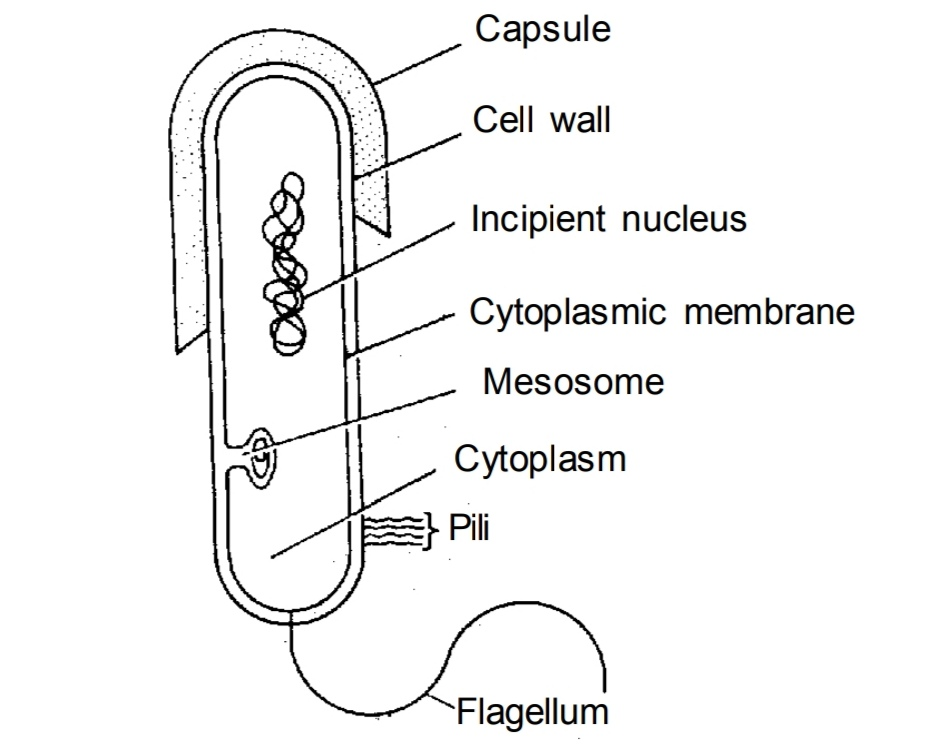
Structure of Eubacteria Cell
Protista:
Unicellular eukaryotic organisms
Use hair-like cilia or whip-like flagella for movement.
The mode of nutrition either be autotrophic or heterotrophic.
E.g. Unicellular Algae, Diatoms, Protozoans, Euglena, Paramecium.
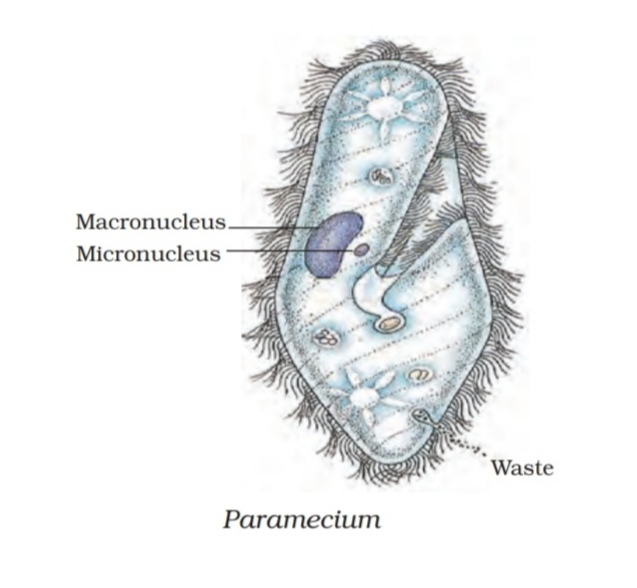
Fungi:
Heterotrophic Eukaryotic Organisms.
Saprotrophs ( use decaying organic matter as food)
Parasites (use living protoplasm of host organisms as food)
Cell wall made up of chitin
Live in a mutual relationship with blue-green algae. (Symbiotic relationship)
The symbiotic Life form is known as lichen.
Lichen grows on the bark of trees as coloured Patches.
E.g. Yeast, molds, mushrooms.
Kingdom Plantae
Multicellular Eukaryotes with cell wall
Autotrophs use chlorophyll for photosynthesis.
Classified based on whether the plant body is well differentiated.
The next Classification is based on whether the differentiated plant body has special tissue for the transport of water and other substances.
Further classification is based on the ability to bear seed and whether seeds are enclosed within a fruit.
Thallophyta:
Commonly known as algae.
Plants do not have well-differentiated bodies.
Predominantly aquatic plants.
E.g. Ulothrix, spirogyra, cladophora, ulva, chara.
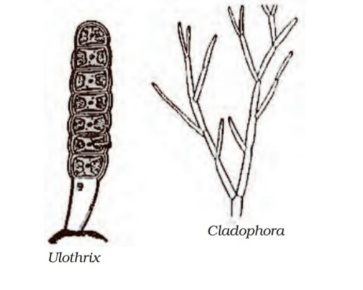
Bryophyta:-
Amphibian of plant Kingdom
The plant body has evolved into a stem and leaf-like structure.
There is no specialized tissue for transporting water and other substances from one section of the plant to another.
E.g. Marchantia, Moss, Riccia.
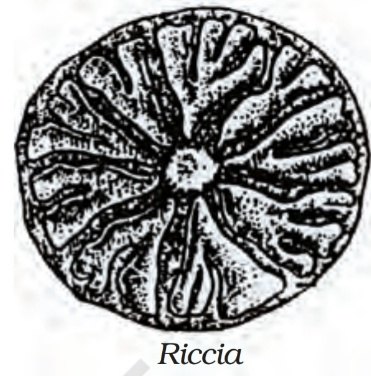
Pteridophyta:-
The plant body differentiates into roots, stems, and leaves.
Specialised tissue for conduction of water and other substances from one part of the plant body to another.
E.g. Marsilea, ferns and horsetails.
Reproductive organs in all three groups are Cryptogams (Hidden reproductive organs).
Plants with well-differentiated reproductive parts make seeds called phanerogams.
Seed consists of embryos along with stored food.
Gymnosperm:-
The term is derived from two Greek words.
Gymno- means naked and Sperma- means seed.
Plants that bear naked seeds are usually perennial, evergreen, and woody.
- E.g. Pines, Deodar.
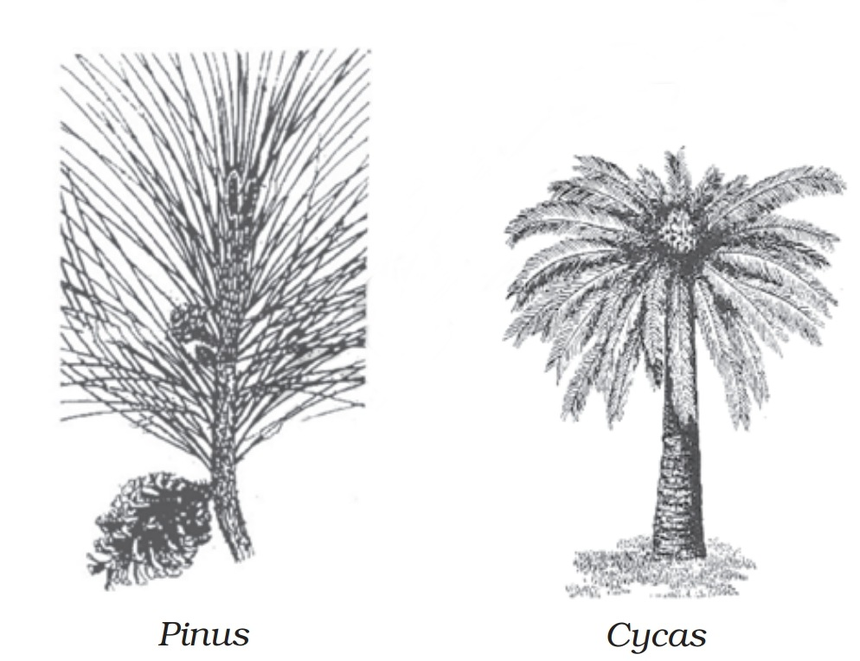
Angiosperms:-
The term is derived from two Greek words.
Angio means covered and Sperma- means seed.
Seeds develop inside an ovary and the ovary is modified to become fruit.
Embryos in seed have structures called Cotyledons.
Based on the number of cotyledons present in the seed, plants are classified into two groups.
Plants with seeds having single cotyledons are called monocots.
Plants with seeds having two cotyledons are called dicots.
Kingdom Animalia
Multicellular eukaryotes without a cell wall.
They are heterotrophs.
Further, classified based on the type of body design differentiation found.
Most are mobile.
Porifera:
Non-motile animals attached to some solid support.
Pores all over the body.
The presence of a canal system helps in circulating water throughout the body to bring food and oxygen.
Covered with a hard skeleton
Commonly known as sponges.
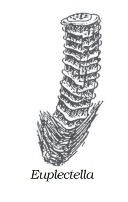
Found in marine habitat.
E g. Sycon, Spongilla, Euplectella.
Coelenterata (Cnidaria):
Animals living in the water
Cavity present in the body.
The body is made up of two layers of cells – one makes the outer layer of the body and the other makes the inner lining of the body.
Some species live in colonies – Corals.
Some species live in solitary- span (Hydra).
E.g. Jellyfish, Sea anemones.
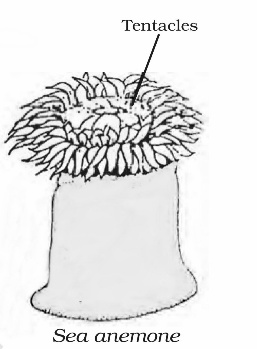
Platyhelminthes:
The body is bilaterally symmetrical. ( Left and right half of body have the same design)
Triploblastic animal (Three-layer of cell from which differentiated tissue is made)
No true internal body cavity or coelom is present.
The body is flattened dorsoventrally. (That’s Why Called Flatworms)
Free-living or Parasites.
- E.g. Free-living (Planaria), Parasitic ( liver flukes).
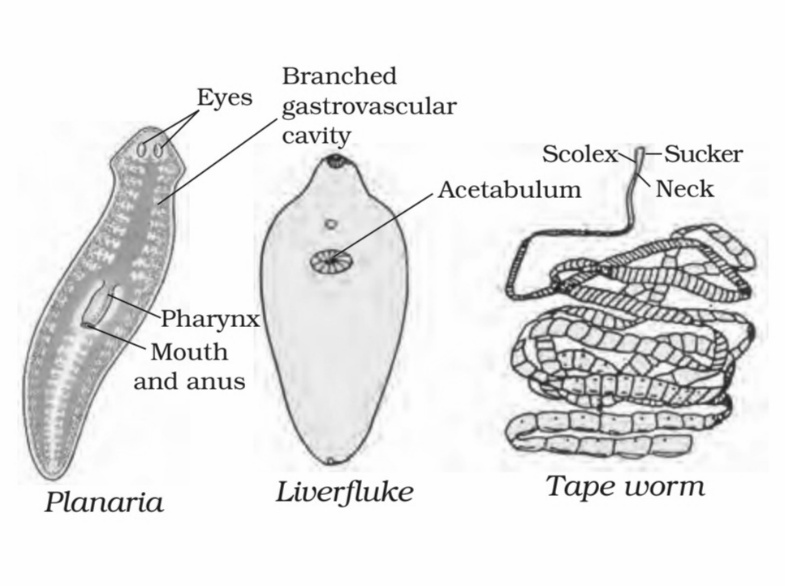
Nematoda (Aschelminthes):
The body is bilaterally symmetrical and triploblastic.
The body is cylindrical
Pseudocoelom is present (No real organ present).
Parasitic Worms cause Elephantiasis (Filarial worm), and worms in the intestine (roundworms)
E.g. Ascaris, Wuchereria.
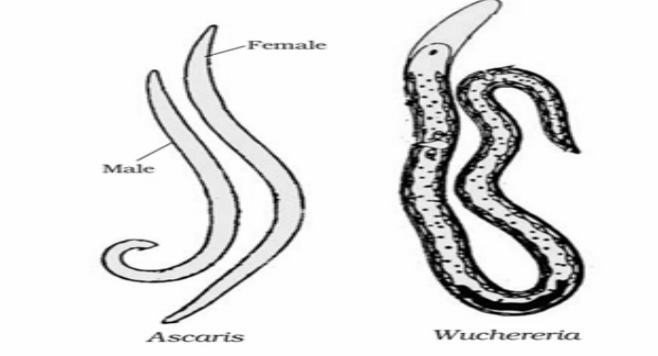
Annelida:
Bilaterally symmetrical and triploblastic.
True body cavity.
Segments lined up one after the other from head to tail.
Found in freshwater, Marine water, as well as on land.
E.g. Earthworms and leeches.
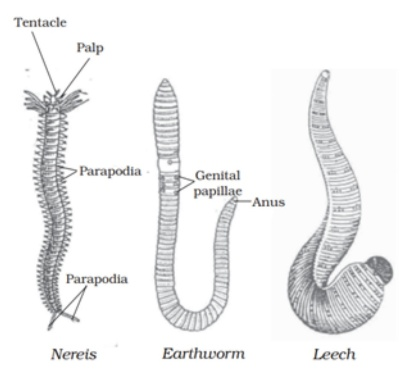
Arthropoda:
The largest group of animals.
Bilateral symmetrical and segmented.
Open circulatory system. ( Blood does not flow in blood vessels)
Jointed legs.
E.g. Prawns, Butterflies, Houseflies, Spiders, Scorpions, and Crabs.
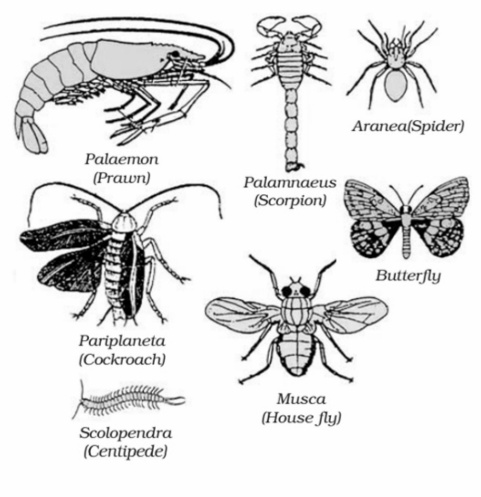
Mollusca:
Bilateral symmetrical.
Little segmentation.
Open circulatory system.
Kidneys are like organs for excretion.
E.g. Snails, mussels.
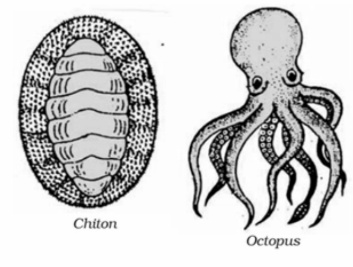
Echinodermata:
Spiny skinned organisms.
Free-living marine animals.
Triploblastic and coelomic cavity.
Water-driven tube system for transportation.
Hard calcium carbonate structure is used as a skeleton.
E.g. Sea stars and Sea urchins.
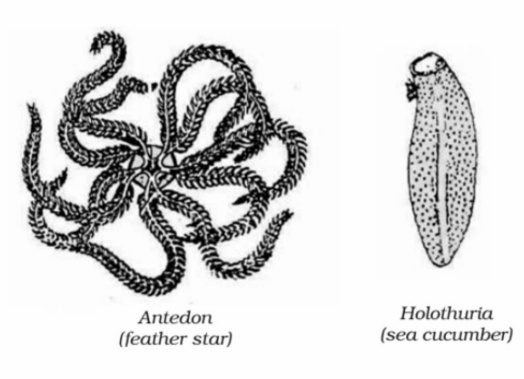
Protochordata:
Bilaterally symmetrical.
Triploblastic and coelomic.
Marine animals
Notochords are present in some stages during their lives.
Notochord- Long rod-like support structure runs along the back of the animals.
E.g. Balanoglossus, Herdmania, Amphioxus.
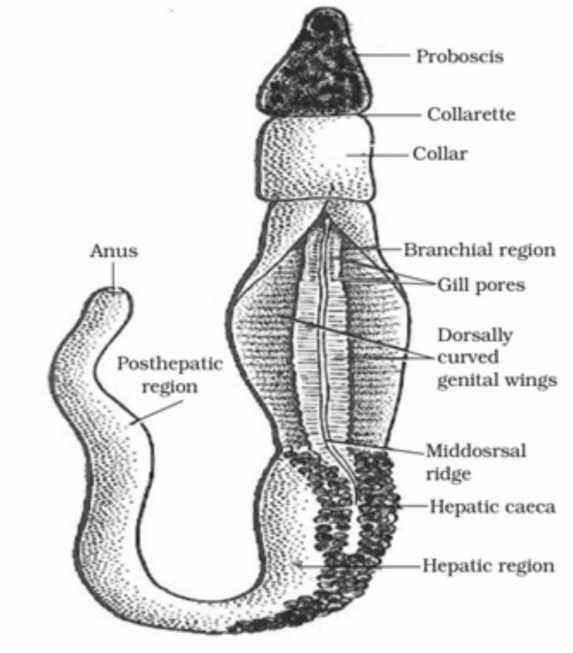
Vertebrata:
True vertebral column and internal skeleton.
Bilaterally symmetrical
Triploblastic, coelomic, and segmented.
Complex differentiation of body tissue
All chordates possess the following features:
Have a notochord
Have a dorsal nerve cord
Are triploblastic
Have paired gill pouches
Are coelomates.
Vertebrates are grouped into six classes:
Cyclostomata:
Jawless vertebrates.
Elongated eel-like body
Circular mouth
Slimy skin and scaleless.
Ectoparasite of other vertebrates.
E.g. Petromyzon, Myxine.

Pisces (Fish):
Exclusively aquatic animal
Skin is covered with scales.
Use dissolved oxygen in water by using gills.
The body is streamlined and a muscular tail is used for movement.
Cold-blooded having two-chambered hearts.
Lay eggs
Some fish have skeletons made up of cartilage E.g. Sharks.
Some fish have skeletons made up of Both bone and cartilage E.g. Tuna or rohu.
Amphibia:
Presence of mucus gland in the skin
Three chambered heart
Respire by either lungs or gills.
Lay eggs
Found in both water and land.
E g. Frog, toads, salamander.
Reptilia:
Cold-blooded animals have scales.
Breathe through lungs.
Most of them have three-chambered hearts except crocodile (Four chambered hearts)
Lay eggs have a tough covering.
E.g. Turtle, Chameleon, Crocodile etc.
Aves:
Warm-blooded animal.
Four chambered hearts.
Lay eggs
The outer covering of feathers.
Two forelimbs are modified for flight.
Breathe through lungs.
All birds fall under this category
E.g. Pigeon, Crow, Sparrow etc.
Mammalia:
Warm-blooded animal
Four chambered hearts.
Mammary gland for the production of milk to nourish their young ones.
The skin has hairs as well as sweat and oil glands.
Most mammals produce live young ones.
Few of them like Platypus, and Echidna lay eggs.
Kangaroo produced very poorly developed young ones.
E.g. Whales, Humans, Bat etc.
Nomenclature
An organism's local name may vary over time.
As a result, each organism's scientific name is distinct and may be used to identify it everywhere in the globe.
The system of scientific naming was introduced by Carolus Linnaeus in the 18th century.
Certain rules are followed while writing the scientific name:
The name of the genus begins with a Capital letter.
The name of a species begins with a small letter.
When printed, scientific names should be in italics.
When written by hand, the genus and the species name should be underlined separately.
Significance of NCERT Notes for Class 9 Science Chapter 7
Diversity in Living Organisms class 9th notes will assist you in revising the chapter and gaining an understanding of the main concepts addressed. These Notes for Class 9 Science Chapter 7 are also not unduly complicated, and they thoroughly explain step-by-step approaches to guarantee that students understand the concepts of this chapter, which is part of the CBSE Science syllabus for class 9. The Diversity in Living Organisms Class 9 notes pdf download can be utilized for offline preparation.
Subject Wise NCERT Exemplar Solutions
Subject wise NCERT Solutions
Chapter-Wise NCERT Class 9 Notes Science
NCERT Class 9th Science Chapter 7 Notes |
NCERT Class 9th Science Chapter 14 Notes |
Frequently Asked Questions (FAQs)
The main topics covered in the Class 9 Science Chapter 7 Notes are the basis of Classification, Classification and Evolution, The Hierarchy of Classification- Groups, Plantae, Animalia, Nomenclature.
Students can expect 10-11 Marks questions from the Chapter Diversity in Living Organisms.
A plant which bears seed Which is not enclosed by fruit. Such a type of plant is known as a gymnosperm. E.g. Pinus.
Canal system in sponges Is present for the passage of water which brings food and oxygen with water current.
As discussed in Class 9 Diversity in Living Organisms notes- Bryophytes are known as amphibia of the plant Kingdom because although they are terrestrial plants They need water for reproduction and fertilisation.
Courses After 12th
Applications for Admissions are open.
As per latest syllabus. Physics formulas, equations, & laws of class 11 & 12th chapters
JEE Main Important Chemistry formulas
Get nowAs per latest syllabus. Chemistry formulas, equations, & laws of class 11 & 12th chapters
JEE Main high scoring chapters and topics
Get nowAs per latest 2024 syllabus. Study 40% syllabus and score upto 100% marks in JEE
JEE Main Important Mathematics Formulas
Get nowAs per latest syllabus. Maths formulas, equations, & theorems of class 11 & 12th chapters
